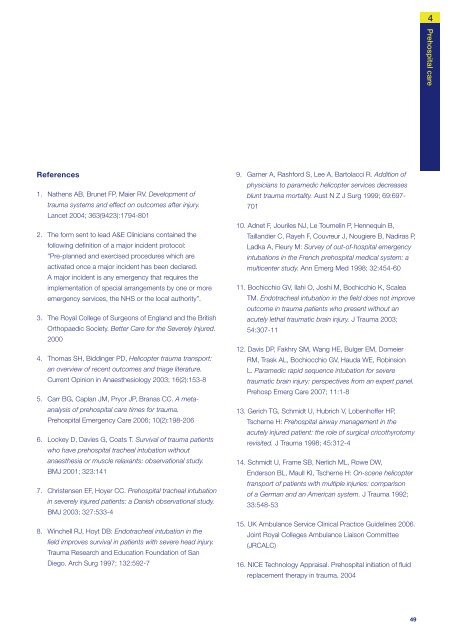NCEPOD: Trauma - Who Cares? - London Health Programmes
NCEPOD: Trauma - Who Cares? - London Health Programmes
NCEPOD: Trauma - Who Cares? - London Health Programmes
You also want an ePaper? Increase the reach of your titles
YUMPU automatically turns print PDFs into web optimized ePapers that Google loves.
4Prehospital careReferences1. Nathens AB, Brunet FP, Maier RV. Development oftrauma systems and effect on outcomes after injury.Lancet 2004; 363(9423):1794-8012. The form sent to lead A&E Clinicians contained thefollowing defi nition of a major incident protocol:“Pre-planned and exercised procedures which areactivated once a major incident has been declared.A major incident is any emergency that requires theimplementation of special arrangements by one or moreemergency services, the NHS or the local authority”.3. The Royal College of Surgeons of England and the BritishOrthopaedic Society. Better Care for the Severely Injured.20004. Thomas SH, Biddinger PD, Helicopter trauma transport:an overview of recent outcomes and triage literature.Current Opinion in Anaesthesiology 2003; 16(2):153-85. Carr BG, Caplan JM, Pryor JP, Branas CC. A metaanalysisof prehospital care times for trauma.Prehospital Emergency Care 2006; 10(2):198-2066. Lockey D, Davies G, Coats T. Survival of trauma patientswho have prehospital tracheal intubation withoutanaesthesia or muscle relaxants: observational study.BMJ 2001; 323:1417. Christensen EF, Hoyer CC. Prehospital tracheal intubationin severely injured patients: a Danish observational study.BMJ 2003; 327:533-48. Winchell RJ, Hoyt DB: Endotracheal intubation in thefi eld improves survival in patients with severe head injury.<strong>Trauma</strong> Research and Education Foundation of SanDiego. Arch Surg 1997; 132:592-79. Garner A, Rashford S, Lee A, Bartolacci R. Addition ofphysicians to paramedic helicopter services decreasesblunt trauma mortality. Aust N Z J Surg 1999; 69:697-70110. Adnet F, Jouriles NJ, Le Toumelin P, Hennequin B,Taillandier C, Rayeh F, Couvreur J, Nougiere B, Nadiras P,Ladka A, Fleury M: Survey of out-of-hospital emergencyintubations in the French prehospital medical system: amulticenter study. Ann Emerg Med 1998; 32:454-6011. Bochicchio GV, Ilahi O, Joshi M, Bochicchio K, ScaleaTM. Endotracheal intubation in the fi eld does not improveoutcome in trauma patients who present without anacutely lethal traumatic brain injury. J <strong>Trauma</strong> 2003;54:307-1112. Davis DP, Fakhry SM, Wang HE, Bulger EM, DomeierRM, Trask AL, Bochiocchio GV, Hauda WE, RobinsionL. Paramedic rapid sequence intubation for severetraumatic brain injury: perspectives from an expert panel.Prehosp Emerg Care 2007; 11:1-813. Gerich TG, Schmidt U, Hubrich V, Lobenhoffer HP,Tscherne H: Prehospital airway management in theacutely injured patient: the role of surgical cricothyrotomyrevisited. J <strong>Trauma</strong> 1998; 45:312-414. Schmidt U, Frame SB, Nerlich ML, Rowe DW,Enderson BL, Maull KI, Tscherne H: On-scene helicoptertransport of patients with multiple injuries: comparisonof a German and an American system. J <strong>Trauma</strong> 1992;33:548-5315. UK Ambulance Service Clinical Practice Guidelines 2006.Joint Royal Colleges Ambulance Liaison Committee(JRCALC)16. NICE Technology Appraisal. Prehospital initiation of fl uidreplacement therapy in trauma. 200449
















